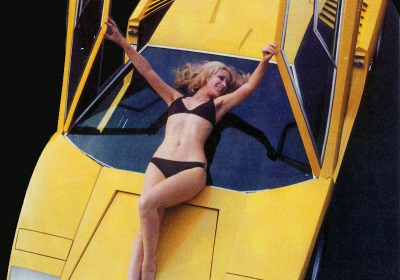Concept Car of the Week: Lamborghini Countach LP500 (1971)
Fri, 11 Oct 2013The rivalry between the raging bull and the prancing horse led the two brands to create some truly amazing sports and super cars. In 1971, delighted by the success of the Miura, Ferrucio Lamborghini naturally went back to Carrozzeria Bertone with the impossible task to design its successor. The Miura was undeniably gorgeous, but wasn't yet on the same level as the Ferraris in terms of performance. Its replacement would have to surpass everything else on the road.
Rather than trying to freshen up the already perfect curves of the Miura, Marcello Gandini looked far into the future and came up with a design that would become one of the most idolized cars ever made.
When he presented his concept drawings for the LP500 prototype to Nuccio Bertone, the latter exclaimed "Countach!", the Piedmontese equivalent to "F**k!". Seduced by the design and enthused by the reaction, Ferrucio Lamborghini decided the exclamation should stick.
The Countach wasn't the first wedge-shaped sports car, nor the first car to feature scissor doors, as the Alfa Romeo Carabo previewed these elements three years earlier. Nevertheless, the Countach seemed like an amalgamation of all those Gandini wedge concepts, simplified and honed to perfection.
From the flat, straight nose to the truncated ruby taillights, every surface connects effortlessly to the next in a harmonious blend of tight curves and polygonal graphics. Gandini has always been more focused on vehicle architecture, assembly and mechanism rather than just the appearance. Perhaps this is the secret behind the success of his designs.
Or perhaps the secret lies in compromises, particularly with regards to passenger comfort. With such radical tumblehome, the interior is famous for being extremely tight; not only in its height, but the wheel wells leave hardly any room for the driver's feet. The dash was very Spartan, featuring a driver-focused fully digital unit mounted on the cross beam and – last but not least – a rear view periscope.
The LP500 carried a 5.0L version of the 3.9L V12 that powered the Miura. 'LP' stood for Longitudinal Posterior, indicating the engine had been turned 90 degrees, with the transmission protruding into the cockpit where the driver had direct shift control. This configuration removed the need for complex and heavy linkages.
The response at the Geneva motor show went beyond expectations, with many orders placed before the car was even announced for production, but the Countach still had a long way to go.
During testing, it became clear that the elegant louvers behind the side windows didn't provide enough cooling for the massive engine, so huge air boxes replaced them. In addition, large NACA air ducts were carved into the smooth bodyside. After several thousands of hard miles, the first ever Countach ended its life in a barrier crash test at MIRA, in UK. Two more prototypes were built to get it to production, a red one and a green one.
The first production Countach came out in 1973 as the LP400. The 5.0L was abandoned after the engine exploded during testing. There wasn't enough time, manpower and money to develop a new engine with bigger bore and stroke. The production version therefore used the 4.0L V12.
The interior was also made more presentable with new IP and leather seats. The doors were made slightly bigger but the rest remained mostly untouched, including the doors and the periscope.
Seeing a Countach is always a memorable moment. It might not be as fast as modern super cars, nor as expensive, yet in the collective mind it still manages to represent THE ultimate driving machine.
Designer Marcello Gandini
First seen Geneva motor show 1971
Engine 4,971cc V12, 434bhp
Height 1,070mm
Length 4,140mm
Width 1,890mm
Wheelbase 2,450mm
Your author, Flavien Dachet, is a UK-based, French-born car designer. You may know him as the purveyor of KarzNshit, a photo blog that if isn't already in your bookmarks, certainly should be.
By Flavien Dachet

